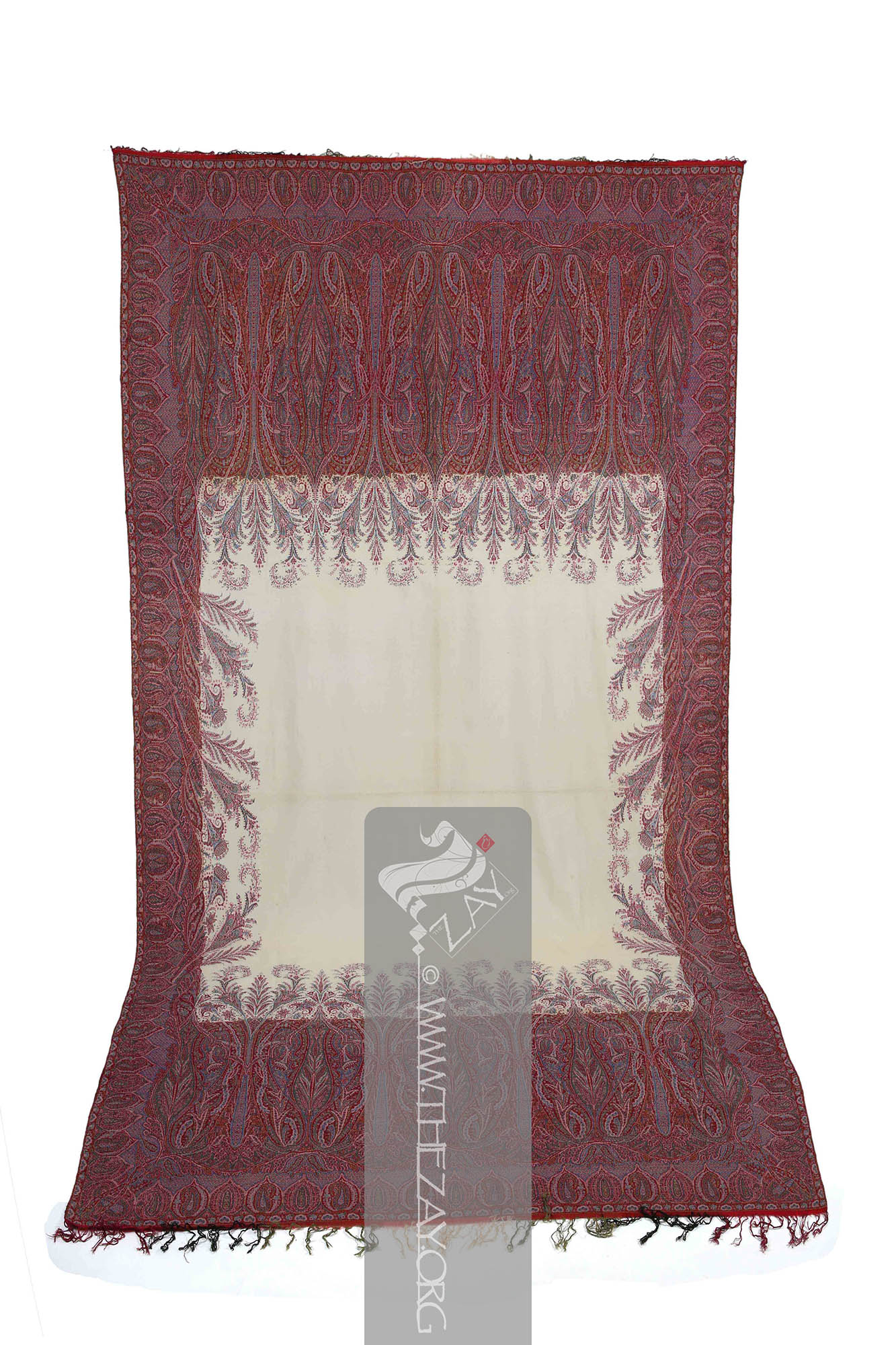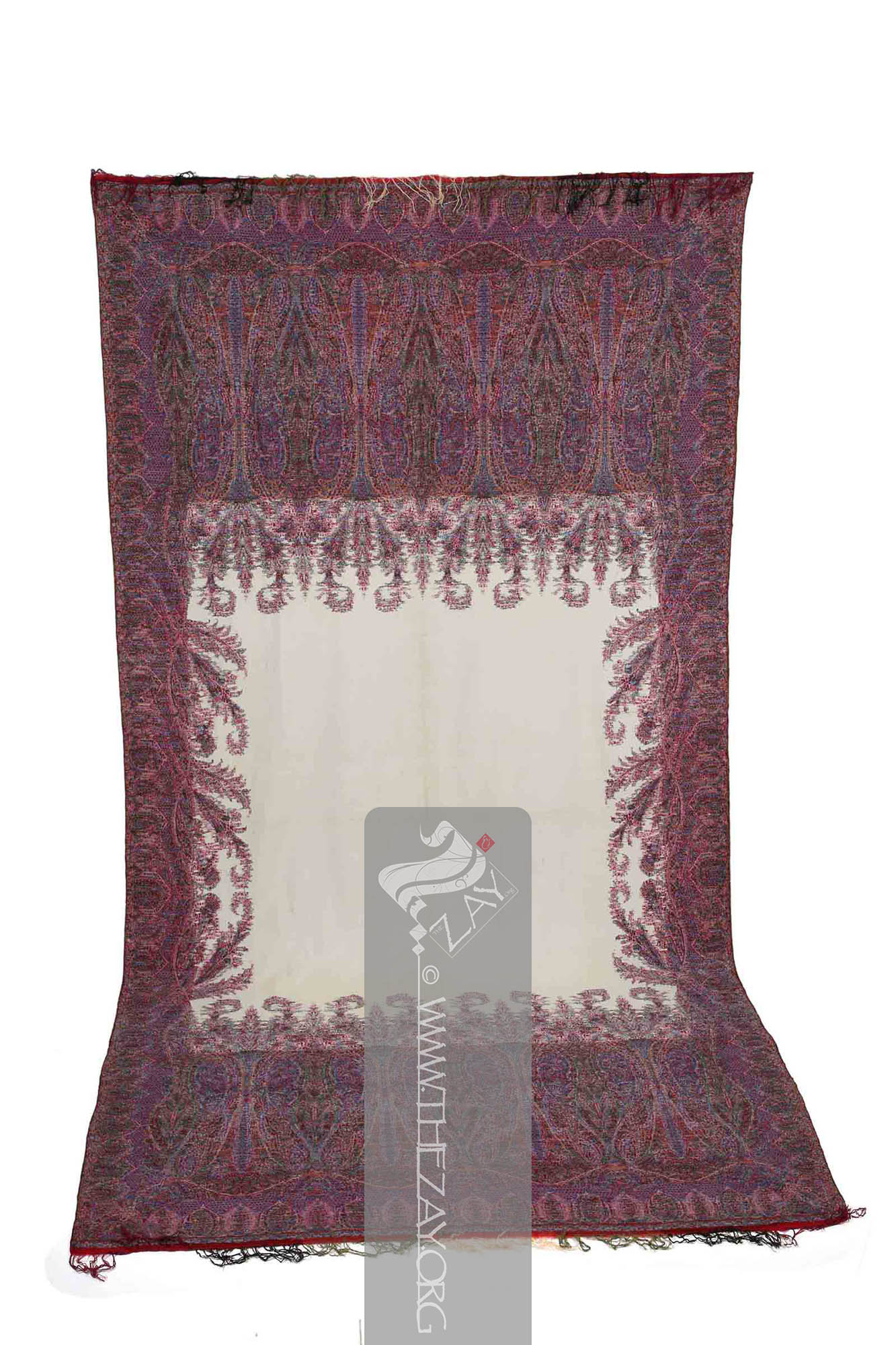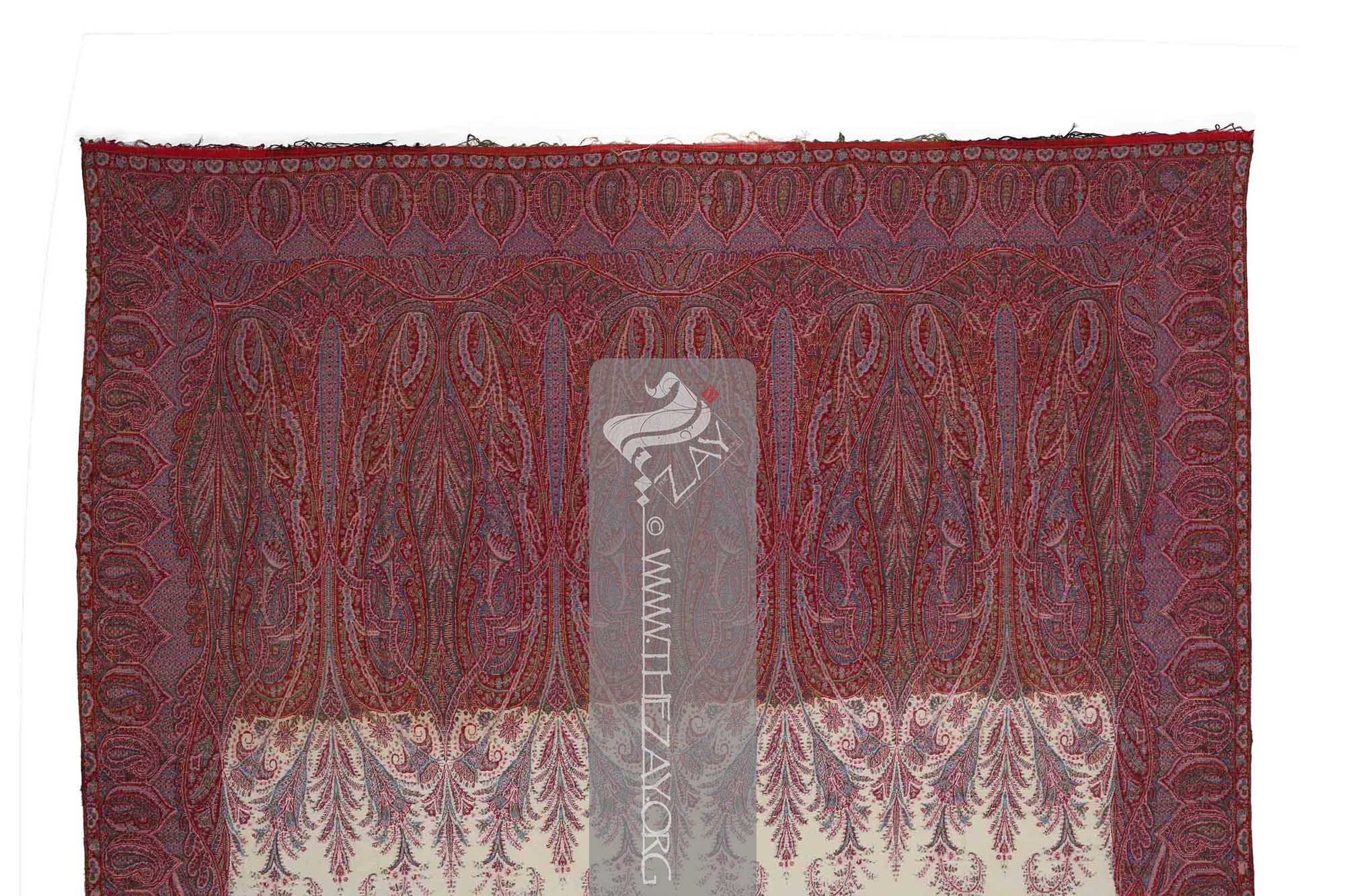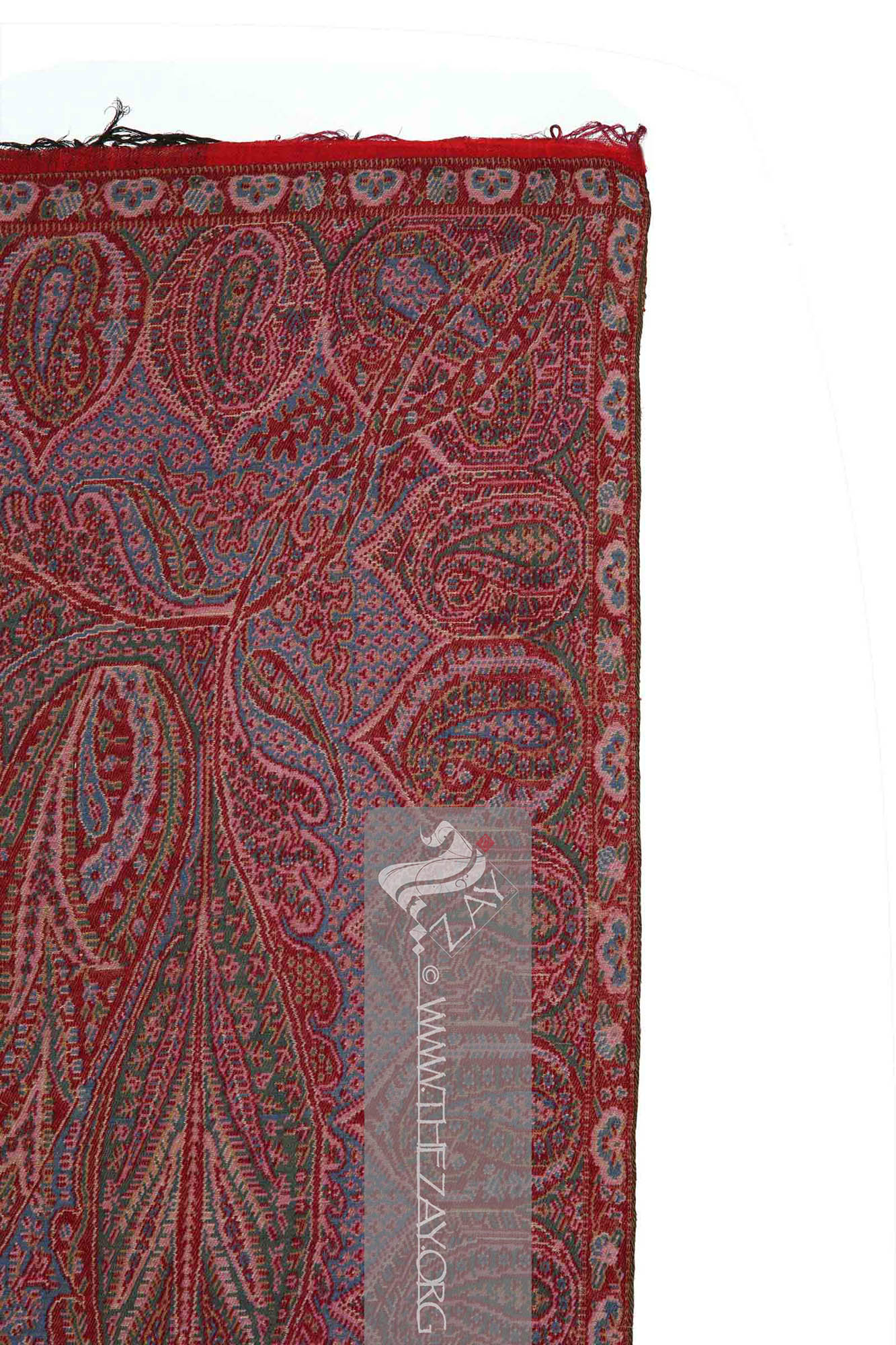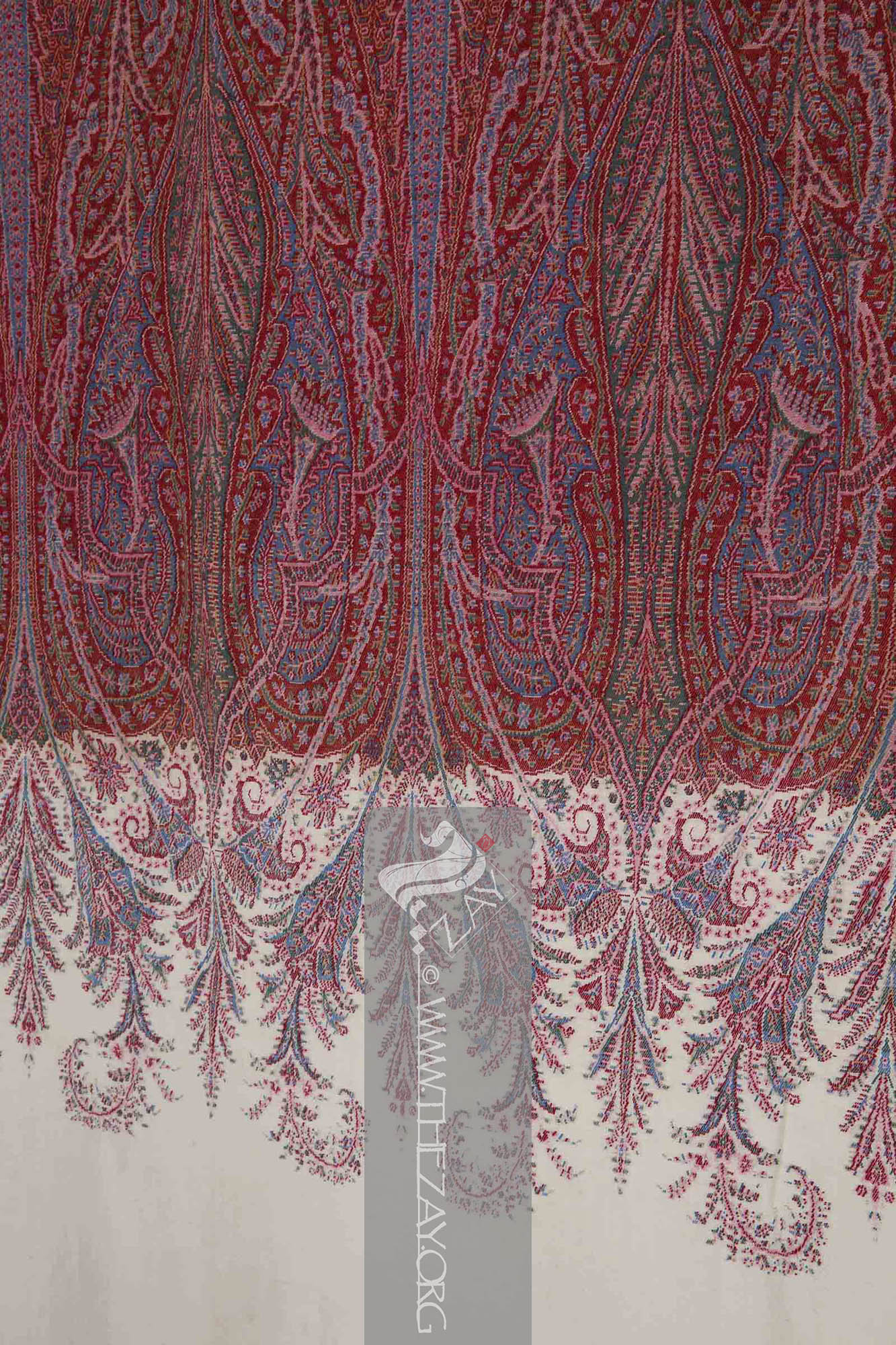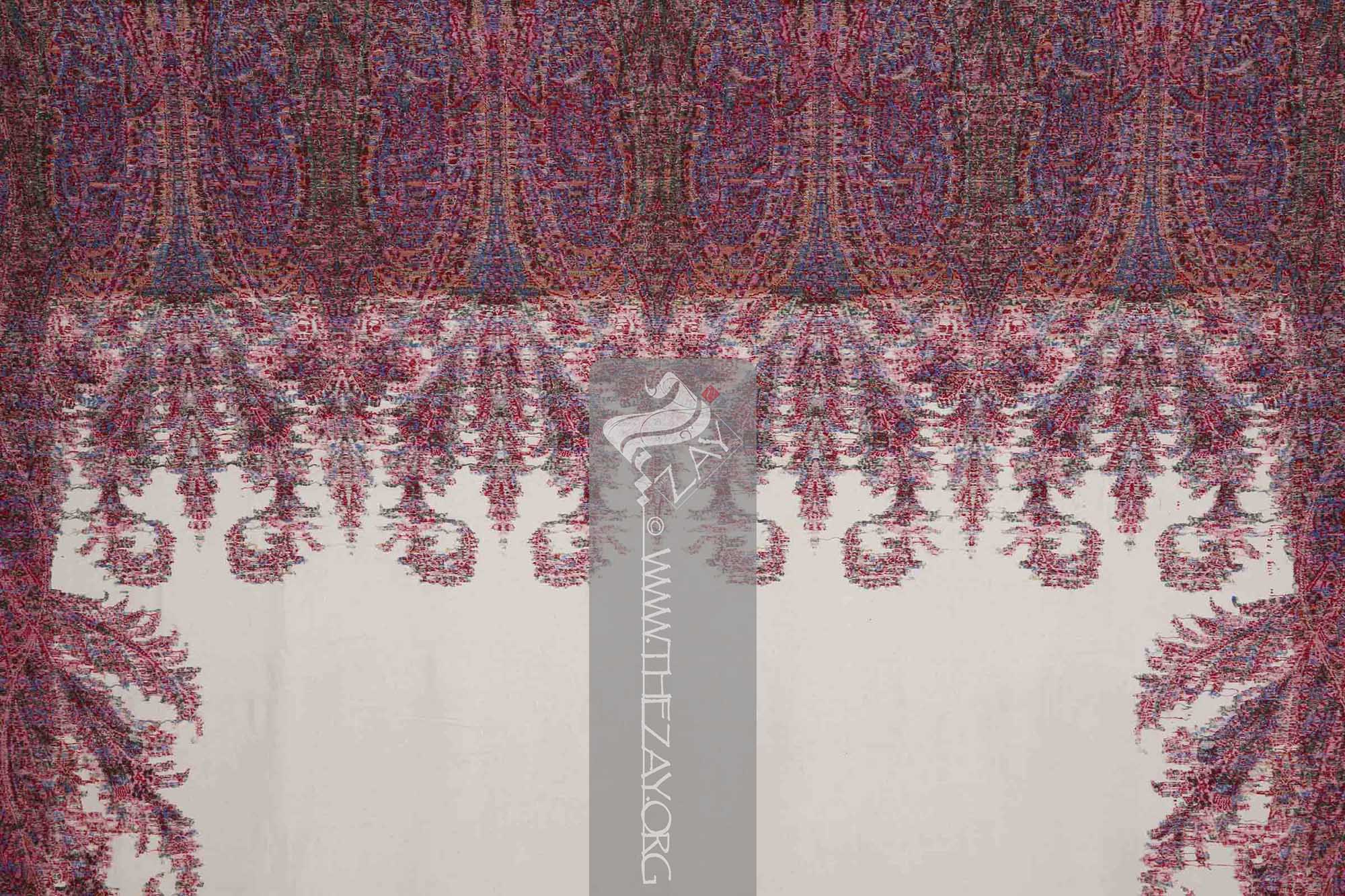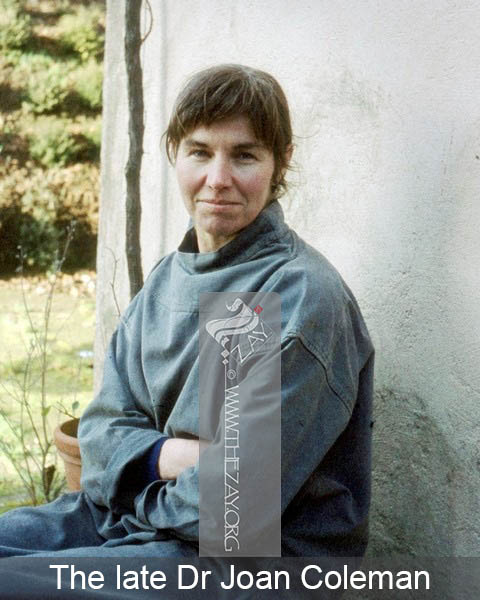Object NotePart of a set of a trio comprising (
ZI2020.500778 EUROPE) and (
ZI2020.500779 EUROPE).
Object HistoryThis (
long_shawl
Long_Shawl
Shawl: (Persian: shāl from Hindi: duśālā – Shoulder Mantle), a shawl is a South Asian version of a scarf worn or wrapped loosely over the shoulders and is usually made of wool. : (Synonym: Kirking Shawl
Shawl: (Persian: shāl from Hindi: duśālā – Shoulder Mantle), a shawl is a South Asian version of a scarf worn or wrapped loosely over the shoulders and is usually made of wool. ), European versions of and inspired by Kashmiri double shawl
Shawl: (Persian: shāl from Hindi: duśālā – Shoulder Mantle), a shawl is a South Asian version of a scarf worn or wrapped loosely over the shoulders and is usually made of wool. s in wool or silk manufactured locally in Europe. As a part of the trousseau for aristocratic women, it was often used at their first post-wedding church services and christenings. ) dating back to the mid-19th century was originally a part of the Dr Joan Coleman Collection and was part of a trio along with (
ZI2020.500778 EUROPE) and (
ZI2020.500779 EUROPE). Later The
Zay
Zay: (Arabic: costume, Pl. azyaā’), a set of clothes in a style typical of a particular country or historical period. Initiative managed to acquire it from Kerry Taylor Auctions in 2020.
Dr Joan Coleman began collecting shawls in 1976 and developed her lifelong passion for collecting. She was a regular at the London salesrooms of Christie’s, Sotheby’s, and Phillips – three of the most outstanding auction houses of the period in the world – getting to know the dealers and learning in the process. She acquired vast knowledge and dedicated hours carefully cataloguing her ever-growing collection. She intended to loan her collection to different museums and institutions for the benefit of learning and education. Her collection is one of the largest and the finest private
shawl
Shawl: (Persian: shāl from Hindi: duśālā – Shoulder Mantle), a shawl is a South Asian version of a scarf worn or wrapped loosely over the shoulders and is usually made of wool. collections to have ever graced the world with shawls ranging from Kashmir,
Paisley
Paisley: (Scottish Gaelic, Pàislig: a town in Scotland), often called buta, boteh, amli, or kalgi in the subcontinent and kazuwah in Arabic, is a Persian tear drop motif with a curved end specially in textiles. Its popularity and subsequent local production in 18th century at Paisley are responsible for its nomenclature., Edinburgh, Norwich, France, and Iran.
Object Features This
long_shawl
Long_Shawl
Shawl: (Persian: shāl from Hindi: duśālā – Shoulder Mantle), a shawl is a South Asian version of a scarf worn or wrapped loosely over the shoulders and is usually made of wool. : (Synonym: Kirking Shawl
Shawl: (Persian: shāl from Hindi: duśālā – Shoulder Mantle), a shawl is a South Asian version of a scarf worn or wrapped loosely over the shoulders and is usually made of wool. ), European versions of and inspired by Kashmiri double shawl
Shawl: (Persian: shāl from Hindi: duśālā – Shoulder Mantle), a shawl is a South Asian version of a scarf worn or wrapped loosely over the shoulders and is usually made of wool. s in wool or silk manufactured locally in Europe. As a part of the trousseau for aristocratic women, it was often used at their first post-wedding church services and christenings. or (
kirking_shawl
Kirking_shawl: (Scottish: Kirk from Old English: cirice – Church; Synonym: Long Shawl
Shawl: (Persian: shāl from Hindi: duśālā – Shoulder Mantle), a shawl is a South Asian version of a scarf worn or wrapped loosely over the shoulders and is usually made of wool. ), European versions of and inspired by Kashmiri double shawl
Shawl: (Persian: shāl from Hindi: duśālā – Shoulder Mantle), a shawl is a South Asian version of a scarf worn or wrapped loosely over the shoulders and is usually made of wool. s in wool or silk manufactured locally in Europe. As a part of the trousseau for aristocratic women, it was often used at their first post-wedding church services and christenings. ) from
Paisley
Paisley: (Scottish Gaelic, Pàislig: a town in Scotland), often called buta, boteh, amli, or kalgi in the subcontinent and kazuwah in Arabic, is a Persian tear drop motif with a curved end specially in textiles. Its popularity and subsequent local production in 18th century at Paisley are responsible for its nomenclature., Scotland dating back to c. 1845-1855 is a (
jacquard
Jacquard: (After Joseph M Jacquard a French weaver and inventor), is referred to both an apparatus with perforated cards invented by the aforementioned Joseph M Jacquard in 1804 fitted to a loom enabling complex intricate weaving patterns and the brocaded fabric woven on a jacquard loom. ) woven piece. With an ivory woollen base. It is woven (
selvedge
Selvedge: (English: Self-finished edge or self-edge: a dialect forming transition), an edge produced on woven fabric during manufacture that prevents it from unravelling. Traditionally the term selvage applied to only loom woven fabric, presently it could be applied to flat knitted fabric too. ) to
selvedge
Selvedge: (English: Self-finished edge or self-edge: a dialect forming transition), an edge produced on woven fabric during manufacture that prevents it from unravelling. Traditionally the term selvage applied to only loom woven fabric, presently it could be applied to flat knitted fabric too. prominently in (
crimson
Crimson: (Persian/Arabic and Turkish: qirmiz or kirmiz – red), is a vivid red color originally made from the dried bodies of a scale insect of the Kermes genus native to the Mediterranean region and was used as a dye for clothing and textiles.) red and (cobalt) blue with touches of yellow (
ochre
Ochre: (Greek: ōkhra – Yellow Ochre), is a natural earth pigment that ranges in colour from yellow to red-brown, often used in art and decoration. ) and pink.
The plain ivory body has protruding foliage motifs in the form of thistles and trumpets framing it from all four sides primarily in cobalt and
crimson
Crimson: (Persian/Arabic and Turkish: qirmiz or kirmiz – red), is a vivid red color originally made from the dried bodies of a scale insect of the Kermes genus native to the Mediterranean region and was used as a dye for clothing and textiles.. An arrangement of a straight sprig of thistle flanked by two tilted ones has repeated alternately with another straight sprig of thistle flanked by two tilted trumpets. Both the arrangements are an extension of the dense and intricate (
phala
Phāla: (Etymological origin: Possibly Indo Persian), the wider layer of pattern that forms the border at each warp
Warp: One of the two basic components used in weaving which transforms thread or yarns to a piece of fabric. The warp is the set of yarns stretched longitudinally in place on a loom before the weft
Weft: one of the two basic components used in weaving that transforms thread or yarns into a piece of fabric. It is the crosswise thread on a loom that is passed over and under the warp threads. is introduced during the weaving process. end or head of a shawl
Shawl: (Persian: shāl from Hindi: duśālā – Shoulder Mantle), a shawl is a South Asian version of a scarf worn or wrapped loosely over the shoulders and is usually made of wool. . ).
The
phala
Phāla: (Etymological origin: Possibly Indo Persian), the wider layer of pattern that forms the border at each warp
Warp: One of the two basic components used in weaving which transforms thread or yarns to a piece of fabric. The warp is the set of yarns stretched longitudinally in place on a loom before the weft
Weft: one of the two basic components used in weaving that transforms thread or yarns into a piece of fabric. It is the crosswise thread on a loom that is passed over and under the warp threads. is introduced during the weaving process. end or head of a shawl
Shawl: (Persian: shāl from Hindi: duśālā – Shoulder Mantle), a shawl is a South Asian version of a scarf worn or wrapped loosely over the shoulders and is usually made of wool. . comprises rows of stylized floral columns of intricately woven foliage forming different patterns resembling lilies, inverted trumpets, and temple steeples. The (
tanjir
Tanjīr: (Possibly Persian: zanjir: Chain), a narrow layer of pattern that forms the border and runs above and below the wider layer. ) in the
phala
Phāla: (Etymological origin: Possibly Indo Persian), the wider layer of pattern that forms the border at each warp
Warp: One of the two basic components used in weaving which transforms thread or yarns to a piece of fabric. The warp is the set of yarns stretched longitudinally in place on a loom before the weft
Weft: one of the two basic components used in weaving that transforms thread or yarns into a piece of fabric. It is the crosswise thread on a loom that is passed over and under the warp threads. is introduced during the weaving process. end or head of a shawl
Shawl: (Persian: shāl from Hindi: duśālā – Shoulder Mantle), a shawl is a South Asian version of a scarf worn or wrapped loosely over the shoulders and is usually made of wool. . on both ends is only present at the bottom and is of the same thickness as the (hashiya). Both the
tanjir
Tanjīr: (Possibly Persian: zanjir: Chain), a narrow layer of pattern that forms the border and runs above and below the wider layer. and the hashiya flaunt the same design where a (
paisley
Paisley: (Scottish Gaelic, Pàislig: a town in Scotland), often called buta, boteh, amli, or kalgi in the subcontinent and kazuwah in Arabic, is a Persian tear drop motif with a curved end specially in textiles. Its popularity and subsequent local production in 18th century at Paisley are responsible for its nomenclature.)/(
buta
Būta: (Anglicized Persian: boteh – Pinecone shaped motif), known as paisley
Paisley: (Scottish Gaelic, Pàislig: a town in Scotland), often called buta, boteh, amli, or kalgi in the subcontinent and kazuwah in Arabic, is a Persian tear drop motif with a curved end specially in textiles. Its popularity and subsequent local production in 18th century at Paisley are responsible for its nomenclature. in English it is the almond or pinecone-shaped motif, especially in textiles. It is believed to have originated from the Cyprus tree a Zoroastrian symbol for life and eternity. In the current Indian context, however, it simply means motif.) is encased within a lotus-style or temple-style arch and is repeated all around the edge. A strip of scarlet fabric with colourful (
satin
Sātin: (Arabic: Zaytuni: from Chinese port of Zayton in Quanzhou province where it was exported from and acquired by Arab merchants), one of the three basic types of woven fabric with a glossy top surface and a dull back. Originated in China and was fundamentally woven in silk.) tasselled fringes is attached on both (
warp
Warp: One of the two basic components used in weaving which transforms thread or yarns to a piece of fabric. The warp is the set of yarns stretched longitudinally in place on a loom before the weft
Weft: one of the two basic components used in weaving that transforms thread or yarns into a piece of fabric. It is the crosswise thread on a loom that is passed over and under the warp threads. is introduced during the weaving process. ) ends. The (
weft
Weft: one of the two basic components used in weaving that transforms thread or yarns into a piece of fabric. It is the crosswise thread on a loom that is passed over and under the warp threads.) end edges are finished with machine-stitched hems giving this piece a very clean finish.
It is important to note that long shawls of similar design distribution were in vogue during this period. With high waistlines, flowing skirts, and (
bodice
Bodice: (English: body), or bodices the plural form of body, it is the close-fitting garment meant to cover the body above the waist or the torso. However, it was not until the 17th century that the term became synonymous to women’s undergarment. ) detailing pintucks and wide puff sleeves of women’s dresses in Great Britain during this time large shawls like this were the perfect accessories for a balanced silhouette. However, the absence of a
jacquard
Jacquard: (After Joseph M Jacquard a French weaver and inventor), is referred to both an apparatus with perforated cards invented by the aforementioned Joseph M Jacquard in 1804 fitted to a loom enabling complex intricate weaving patterns and the brocaded fabric woven on a jacquard loom. loom until the 1820s made it impossible for
shawl
Shawl: (Persian: shāl from Hindi: duśālā – Shoulder Mantle), a shawl is a South Asian version of a scarf worn or wrapped loosely over the shoulders and is usually made of wool. manufacturers to weave the entire piece in the same loom. Hence manufacturers usually produced the
shawl
Shawl: (Persian: shāl from Hindi: duśālā – Shoulder Mantle), a shawl is a South Asian version of a scarf worn or wrapped loosely over the shoulders and is usually made of wool. , and its borders separately and then stitched them together.
By the 1850s with the widening of skirts and (
crinolines
Crinolines: (Latin: crinis – hair, linum – thread, Synonym – Hoop skirt), a hooped or structured petticoat made of a stiff fabric which is composed of horsehair and cotton or linen thread. It was designed to hold a woman’s skirt out and became popular in the 19th century in Europe and the USA.) frames, these shawls became even more popular as it was difficult to wear a jacket or a coat. This resulted in the inclusion of at least one such
shawl
Shawl: (Persian: shāl from Hindi: duśālā – Shoulder Mantle), a shawl is a South Asian version of a scarf worn or wrapped loosely over the shoulders and is usually made of wool. in the wedding trousseau of every lady from the aristocracy thus giving rise to the term (
kirking_shawl
Kirking_shawl: (Scottish: Kirk from Old English: cirice – Church; Synonym: Long Shawl
Shawl: (Persian: shāl from Hindi: duśālā – Shoulder Mantle), a shawl is a South Asian version of a scarf worn or wrapped loosely over the shoulders and is usually made of wool. ), European versions of and inspired by Kashmiri double shawl
Shawl: (Persian: shāl from Hindi: duśālā – Shoulder Mantle), a shawl is a South Asian version of a scarf worn or wrapped loosely over the shoulders and is usually made of wool. s in wool or silk manufactured locally in Europe. As a part of the trousseau for aristocratic women, it was often used at their first post-wedding church services and christenings. ) especially in Scotland as they were worn to the kirk or church on the first Sunday after the wedding and then again at christenings of children.




